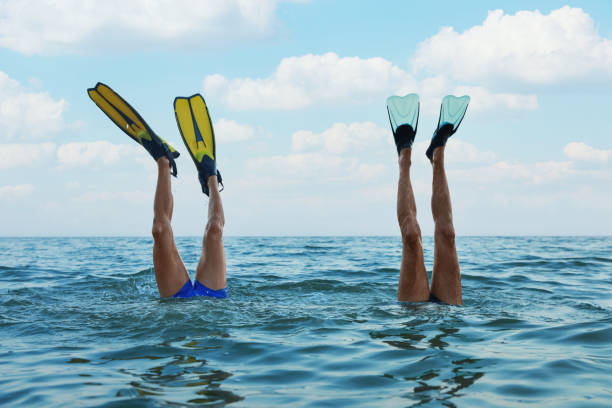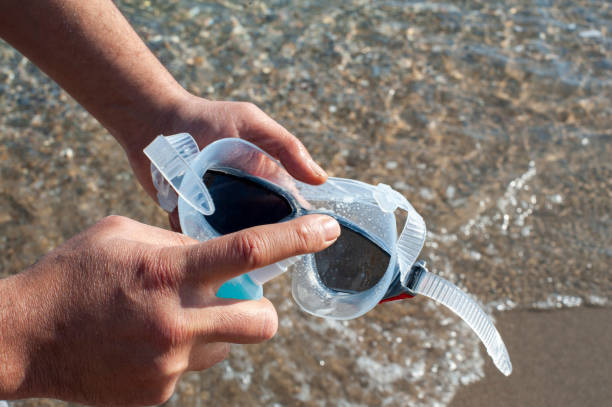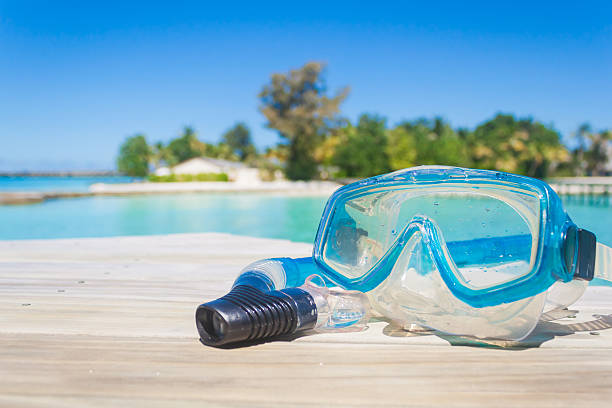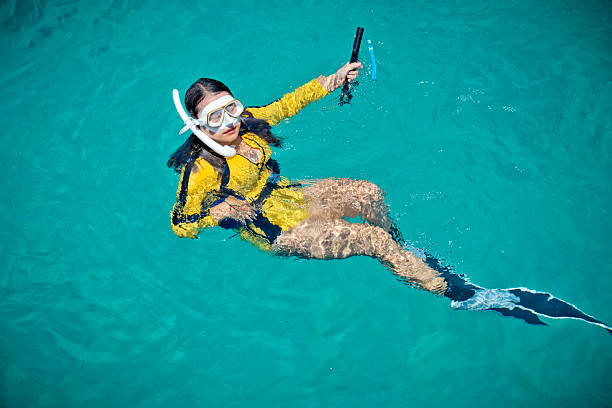Fins are essential tools for any underwater activity, shaping how easily and efficiently you move. Snorkeling fins are ideal for surface exploration, while scuba fins provide the strength and control needed for deeper dives. In this guide, we will break down the main differences between them and provide practical tips to help you pick the best fins for your underwater activities.
What Are Snorkeling Fins and Scuba Fins?

Snorkeling Fins: Lightweight and Flexible
Snorkeling fins are designed for surface swimming and shallow diving. They are generally shorter, lighter, and more flexible compared to scuba fins. This design allows snorkelers to move smoothly on the surface without tiring their legs quickly. Typically, snorkeling fins are between 14 and 18 inches in length. The shorter length reduces drag and makes it easier to maneuver in calm waters or around coral reefs.
The material used in snorkeling fins often includes soft rubber or silicone, which adds to comfort. Many models also feature an open-heel design, which allows for adjustable straps. This makes them easy to put on or remove, even in wet conditions.
Scuba Fins: Longer, Stiffer, and More Powerful
Scuba fins, on the other hand, are built for deeper dives and prolonged underwater activity. They are usually longer, stiffer, and heavier than snorkeling fins. This design allows divers to generate more thrust with each kick, helping them move efficiently while carrying additional gear such as tanks and weights. Scuba fins generally range from 18 to 28 inches in length.
The stiffer blade provides greater propulsion per kick, which is essential when moving through strong currents or swimming at depth. Materials often include reinforced plastic, fiberglass, or carbon fiber. While heavier, these fins allow divers to conserve energy by making each stroke more effective. Open-heel scuba fins are common, as they can accommodate booties, which protect the feet from cold water and rocky surfaces.
Key Differences Between Snorkeling Fins and Scuba Fins

Length and Stiffness
Length and stiffness are two of the most noticeable differences. Shorter, more flexible snorkeling fins are ideal for surface swimming. They allow for quick, easy kicks with minimal resistance. In contrast, longer and stiffer scuba fins provide more propulsion per kick, which is crucial for carrying heavy equipment underwater.
For example, a flexible snorkel fin may only require 30–40% of your leg strength to move effectively on the surface. A stiff scuba fin, however, may need 50–60% of your leg strength per kick, but it propels you 1.5–2 times farther with each movement. This difference makes scuba fins more efficient for longer dives, while snorkel fins reduce fatigue during casual swimming.
Blade Shape and Design
Blade design affects how water is displaced with each kick. Snorkeling fins often feature wide, slightly curved blades, giving a smooth and comfortable ride. Scuba fins may have straight, slightly angled, or split blades. Straight blades provide strong forward thrust, while split blades reduce ankle fatigue by allowing water to flow through the split, decreasing resistance.
Some advanced scuba fins combine angled and vented designs to improve efficiency. For instance, the Vanguard V-2000 has a vented blade that channels water efficiently, reducing drag by approximately 15% compared to a standard solid blade. This feature allows divers to move more efficiently without tiring too quickly.
Material and Durability
Snorkeling fins prioritize comfort, so softer materials like rubber or silicone are common. These materials reduce foot fatigue and are more forgiving if the fins hit rocks or coral. Scuba fins often use reinforced plastics, fiberglass, or carbon fiber. While these materials increase weight slightly, they provide durability and high thrust. They also resist deformation under prolonged use or extreme water pressure.
For instance, carbon fiber scuba fins may cost more upfront, but they last years longer than standard rubber fins. The trade-off is worth it for professional divers or those who dive frequently.
वजन और पोर्टेबिलिटी
Weight is another critical factor. Snorkeling fins are lightweight and easy to carry, making them ideal for travel or quick trips. Scuba fins are heavier and bulkier, which can be a challenge to transport. However, their extra weight is compensated by the increased efficiency underwater.
A typical snorkeling fin weighs around 1–1.5 pounds per pair, while a scuba fin can weigh 2.5–4 pounds. Despite the difference, divers often prefer the extra power that heavier fins provide, especially when moving against currents or carrying additional gear.
Foot Pocket Type
The foot pocket design differs between the two types. Snorkeling fins often use a full-foot pocket, which slips directly over the foot like a shoe. This design is comfortable for warm water and easy to put on. Scuba fins frequently use an open-heel design with adjustable straps. This design allows divers to wear neoprene booties for thermal protection, abrasion resistance, and additional support in cold or rough environments.
उपयोग का उद्देश्य
Finally, intended use drives many of the differences. Snorkeling fins are for casual swimming and shallow exploration. Scuba fins are engineered for deeper diving, technical maneuvers, and long-duration underwater activity. Choosing the wrong fin type can lead to discomfort, reduced performance, or even injury.
For instance, using flexible snorkeling fins on a 60-foot dive with full scuba gear can cause rapid fatigue and inefficient movement. Conversely, wearing stiff scuba fins while snorkeling can feel cumbersome and reduce agility on the surface.
How to Choose the Right Fins for Your Underwater Adventures

Choosing the right fins depends on your diving style, environment, and personal preference. Here are some professional tips to help you make the best choice.
Consider Your Activity
Identify your primary activity. Are you snorkeling in tropical reefs, or doing deep scuba dives? If most of your time is spent near the surface, lightweight snorkeling fins are sufficient. For regular scuba diving, especially in open water or colder environments, invest in stiffer, longer scuba fins.
Match Fin Length and Stiffness to Your Strength
Your leg strength and swimming style should influence fin selection. Shorter, flexible fins suit swimmers with less leg strength or those who prefer gentle propulsion. Stronger divers can benefit from stiffer fins that provide more thrust per kick. Testing different fins in water helps ensure comfort and efficiency.
Check Blade Type
Blade type affects maneuverability and effort. Flexible snorkeling fins make turns easy and allow quick surface movements. Scuba fins with split or vented blades reduce ankle strain and conserve energy during long dives. Understanding blade mechanics can prevent overexertion and improve safety.
Evaluate Foot Pocket Comfort
Comfort is crucial, especially during extended use. Snorkeling fins should fit snugly but not pinch the foot. Scuba fins should accommodate booties without causing pressure points. Poor fit can lead to blisters, cramps, or even difficulty controlling your kicks underwater.
Material Durability and Maintenance
Consider the environment and frequency of use. Soft rubber fins are ideal for occasional snorkeling trips but may wear faster in rough waters. High-quality scuba fins with reinforced materials are better for frequent diving and harsher conditions. Proper rinsing after saltwater use and storage out of direct sunlight can extend the lifespan of both types.
Weight and Travel Considerations
If travel is frequent, weight and portability matter. Some scuba fins are heavy and take up space in luggage. Travel-friendly snorkeling fins are easy to pack and light to carry. However, if diving performance is the priority, a slightly heavier fin is acceptable.
Personal Preference and Technique
Personal preference plays a role in fin selection. Some divers prefer the feel of longer fins, while others enjoy the agility of shorter ones. Testing different fins before committing is the best way to ensure comfort and efficiency.
अंतिम विचार
Fins play a key role in how efficiently you move underwater. Snorkeling fins provide flexibility and ease for surface swimming, while scuba fins give the power and control needed for deeper dives. Knowing the differences ensures you conserve energy, maintain stability, and enjoy every moment below the water with confidence.
पर वेनगार्ड तैराकी, our fins are designed for both performance and comfort. Whether exploring coral reefs or navigating open water, you can rely on them to support your movements. Check out our collection today, find the fins that suit your diving style, and make every underwater adventure smoother and more enjoyable.



